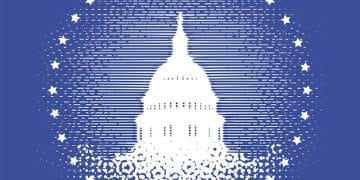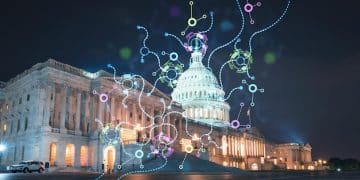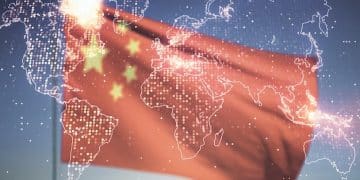US Human Rights: A Critical Examination

Advertisements
The United States’ stance on international human rights is complex. It balances its proclaimed advocacy with strategic foreign policy objectives, leading to inconsistencies.
This article explores the intricate dance between principle and pragmatism. We embark on a critical examination of the US stance on international human rights.
Advertisements
We question how its actions align with its stated values on the world stage. We will explore the challenges and inconsistencies in its application of these principles.
Historical Foundations and Evolving Doctrines
The United States has historically presented itself as a beacon of human rights. This narrative is rooted in its founding documents, which enshrine concepts of individual liberty.
This foundational commitment gained international traction after World War II with the establishment of the UN and the Universal Declaration of Human Rights. The UDHR was heavily influenced by American legal traditions.
Advertisements
The application of these principles has rarely been straightforward. The US approach has constantly evolved, reflecting internal political debates and changing global dynamics.
The Cold War Context
During the Cold War, human rights were frequently weaponized as an ideological battleground. The US criticized abuses in the Soviet bloc, highlighting a contrast with democratic freedoms.
Support for human rights sometimes aligned with strategic interests, bolstering alliances against communism. Conversely, human rights concerns were often downplayed when dealing with authoritarian allies.
This period saw a selective application of human rights principles. This dynamic interplay has shaped not only foreign policy but also its perception internationally.
Post-Cold War Adjustments
The end of the Cold War brought a renewed focus on human rights. The 1990s saw humanitarian interventions, though these were often controversial.
Human rights became integrated into trade and aid policies, with conditions sometimes linked to a nation’s human rights record. New challenges, like human trafficking, also emerged.
In conclusion, the US stance reflects a continuous negotiation between idealistic aspirations and pragmatic considerations. Its expression has adapted significantly to different global contexts.
Policy Implementation and Diplomatic Tools
The implementation of US human rights policy is a multi-faceted endeavor. It uses a range of diplomatic tools, from public denunciations to foreign aid.
The State Department’s annual Human Rights Reports are a significant publication. They meticulously document the human rights situation worldwide and serve as a basis for policy decisions.
Sanctions are another powerful tool, imposed on individuals or nations engaging in violations. The effectiveness and ethical implications of sanctions are subjects of ongoing debate.
Use of Sanctions
Sanctions are a frequently deployed instrument, aiming to penalize human rights abusers. The Magnitsky Act, for example, allows the US to sanction foreign individuals.
While broad sanctions can impact entire economies, targeted sanctions aim to minimize harm to the general population. They focus on specific individuals or entities.
The long-term effectiveness of sanctions remains a topic of considerable scholarly and political debate. The results across various cases have been mixed.
Diplomatic Engagement
Direct engagement is a softer, yet vital, approach to human rights promotion. The US engages in bilateral dialogues and multilateral forums.
Active participation in the UN Human Rights Council allows the US to raise concerns and build consensus. Public diplomacy also promotes democratic values.
In summary, the US uses a diverse toolkit to implement its human rights policy. Its effectiveness depends on context, the nature of the violations, and political will.
Challenges and Inconsistencies in Application

The US is often criticized for inconsistencies in its application of human rights principles. Critics argue that the US tends to highlight abuses in adversary nations.
This is while often downplaying or overlooking similar violations committed by its allies. This perceived double standard undermines the moral authority of US foreign policy.
Domestic human rights challenges within the US also complicate its advocacy abroad. Issues like racial inequality and police brutality are frequently cited by international observers.
The “Double Standard” Critique
The accusation of applying a double standard is a persistent thorn in the side of US human rights policy. Concerns are often amplified or muted based on a country’s geopolitical alignment.
Nations with strong economic ties to the US may receive less scrutiny. The language used to describe abuses can vary significantly, depending on whether the perpetrator is an ally or an adversary.
This fuels accusations of hypocrisy. It makes it harder for the US to persuade other nations to adhere to standards it sometimes fails to meet domestically.
Domestic Human Rights Issues
Internal human rights challenges at home complicate US efforts to promote these values abroad. Ongoing struggles with systemic racism and social inequalities affect perceptions of US commitment.
Concerns about police accountability and mass incarceration also draw international criticism. The treatment of migrants and asylum seekers has been a frequent subject of scrutiny.
Ultimately, inconsistencies in US policy stem from a complex interplay of internal priorities and geopolitical realities. Addressing them requires a willingness to confront difficult domestic issues.
International Law and Multilateral Engagement
The United States has a complicated relationship with international human rights law. While instrumental in creating the UDHR, its approach to ratifying treaties has been selective.
It has not ratified several core treaties, such as the Convention on the Rights of the Child (CRC) and CEDAW. This often stems from concerns about national sovereignty.
Despite these reservations, the US actively participates in numerous international forums. This allows it to exert influence and build consensus on human rights issues.

Engagement with the UN Human Rights Council
The UN Human Rights Council (UNHRC) is a key forum for US human rights diplomacy. The Biden administration rejoined the UNHRC, signifying a renewed commitment.
The US frequently sponsors or co-sponsors resolutions. It also undergoes and participates in the Universal Periodic Review (UPR) process, where its record is reviewed.
This selective engagement defines much of its interaction with global human rights architectures. It balances legal commitments with political and legal considerations.
Non-Ratified Treaties and Their Implications
The US’s non-ratification of certain key treaties creates a unique dynamic. It is the only UN member state not to have ratified the CRC.
Non-ratification is often attributed to concerns about parental rights and state sovereignty. Similarly, non-ratification of CEDAW is often attributed to its potential impact on US law.
The failure to ratify these treaties is often raised by other nations. This fuels accusations of hypocrisy, impacting its credibility on the global stage.
Future Directions and Evolving Challenges
The landscape of international human rights is constantly evolving, presenting new challenges. The rise of new technologies, like AI, poses complex ethical dilemmas.
Climate change also presents a growing human rights challenge. Its impacts on displacement and access to resources disproportionately affect vulnerable populations.
The global rise of authoritarianism also necessitates a renewed focus on defending democratic institutions. The US faces the challenge of actively supporting civil society.
Technology and Human Rights
The digital revolution presents both opportunities and threats to human rights. There’s the challenge of protecting privacy in an era of widespread data collection.
Ensuring online freedom of speech and access to information is crucial while combating hate speech and disinformation. Developing ethical guidelines for AI is also vital.
The intersection of technology and human rights is becoming a central feature of international discourse. It demands innovative and adaptable policy responses.
Climate Change and Human Rights
The environmental crisis is increasingly recognized as a human rights issue. Climate-induced migration forces millions from their homes, raising concerns about their rights.
Climate change also exacerbates conflicts over water and food. This impacts the right to adequate living standards.
It also presents a need for environmental justice. This involves addressing the disproportionate impact of climate change on marginalized communities and advocating for equitable solutions.
Public Opinion and Advocacy’s Influence
Public opinion within the US plays a substantial role in shaping the government’s approach. Grassroots movements and advocacy groups have been instrumental in raising awareness.
These groups use various strategies, including lobbying Congress and organizing public protests. They keep human rights issues on the political agenda and influence foreign policy decisions.
The media also acts as a critical intermediary. It informs the public about abuses abroad, but can also be selective in its coverage.
Role of Non-Governmental Organizations (NGOs)
NGOs are powerful advocates, providing crucial information and pressure. Organizations like Human Rights Watch and Amnesty International meticulously document abuses.
They actively engage with Congress and the Executive Branch, advocating for specific legislation or diplomatic actions. Through public campaigns, they raise awareness.
This influences voter sentiment and contributes to policy debates. The ongoing efforts of these groups ensure that human rights issues are not overlooked.
Impact of Media Cycles
Media attention can significantly influence public and political interest. Concentrated media coverage can bring specific crises to the forefront, creating pressure for government response.
Sustained coverage is vital for maintaining public awareness and preventing issues from fading from the agenda. The media frames stories in ways that influence public perception of abuses.
This creates both opportunities and constraints for US foreign policy. It highlights the importance of an informed public in shaping human rights advocacy.
Self-Correction and Accountability Mechanisms
For any credible human rights advocate, mechanisms for self-correction are paramount. The US, while critical of others, also faces scrutiny regarding its own record.
Domestic legal and political processes, such as congressional oversight and judicial review, function as internal checks. This provides avenues for ongoing improvement.
Additionally, a vibrant civil society monitors and reports on human rights practices within the US. Their reports pressure the government to address identified deficiencies.
Congressional Oversight
Congress plays a significant role in scrutinizing US human rights policy. Congressional committees hold hearings to examine human rights situations worldwide.
Congress has the power to pass laws, like the Global Magnitsky Act. It also influences foreign aid budgets, which can be conditioned on human rights performance.
This gives Congress a powerful tool to influence executive action. It provides an important check on the government’s foreign policy decisions.
Judicial Review and Domestic Advocacy
The US legal system and civil society contribute to internal accountability. The Constitution provides a framework for protecting fundamental rights domestically.
Domestic human rights organizations monitor government actions, publish reports, and litigate cases. This ecosystem of internal scrutiny is a hallmark of a democratic system.
It provides crucial avenues for addressing inconsistencies. It ensures the US is held accountable to its own proclaimed standards and international obligations.
| Key Point | Brief Description |
|---|---|
| 📜 Historical Context | US stance stems from founding ideals, evolving through Cold War and post-Cold War eras, balancing principles with strategic interests. |
| ⚖️ Policy Implementation | Uses tools like State Department reports, sanctions, diplomatic engagement, and foreign aid to promote human rights. |
| 🚧 Challenges & Inconsistencies | Faces criticism for “selectivity” in addressing abuses and for domestic human rights issues affecting its credibility. |
| 🌐 Multilateral Engagement | Engages actively in UN forums, despite selective ratification of international human rights treaties. |
Frequently Asked Questions About US Human Rights Policy
The core principles guiding US foreign policy on human rights are generally rooted in the Universal Declaration of Human Rights and its own founding documents, emphasizing universal freedoms, democracy, and dignity. However, their application often involves balancing idealistic principles with pragmatic national and geopolitical interests, leading to a sometimes inconsistent approach.
The US is often criticized for “selective” application because it tends to highlight abuses in rival or adversarial nations while sometimes being perceived as less vocal or overlooking similar violations in allied countries. This perceived double standard can undermine its moral authority, suggesting that strategic interests sometimes override universal human rights commitments.
Domestic human rights issues, such as racial inequality, police brutality, and immigration policies, significantly impact the US’s international standing. These internal challenges reduce its credibility when advocating for human rights abroad, leading to accusations of hypocrisy and making it harder to persuade other nations to adhere to standards it struggles to meet at home.
International treaties play a complex role for the US. While it was instrumental in drafting key documents like the UDHR and has ratified some treaties (e.g., ICCPR, CAT), it has selectively not ratified others (e.g., CRC, CEDAW). This stance balances global engagement with concerns about national sovereignty and domestic legal implications, influencing its perceived commitment.
Emerging human rights challenges include the ethical dilemmas posed by new technologies (AI, surveillance), the human rights impacts of climate change (displacement, resource scarcity), and the global rise of authoritarianism. Addressing these complexities requires adaptability, consistency, and sustained international cooperation to uphold universal human dignity effectively.
The US stance on international human rights is a multifaceted narrative, woven from historical ideals, pragmatic foreign policy, and continuous self-assessment.
While it often positions itself as a champion of universal values, its approach is frequently marked by inconsistencies driven by geopolitical considerations, domestic realities, and the inherent complexities of applying abstract principles to a diverse world.
This critical examination reveals a dynamic tension between aspiration and implementation, where the pursuit of human dignity must constantly navigate the intricacies of power, sovereignty, and evolving global challenges.
Ultimately, understanding this stance requires appreciating both its foundational commitments and the ongoing efforts to reconcile them with the realities of international relations.





